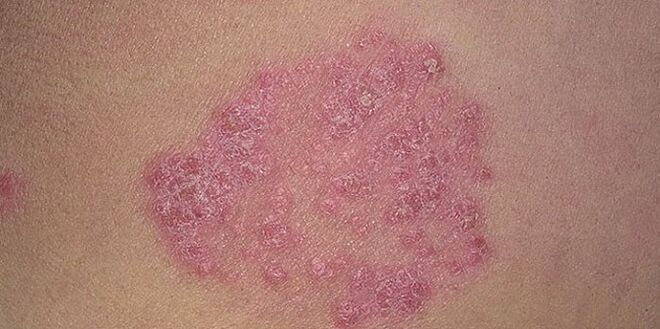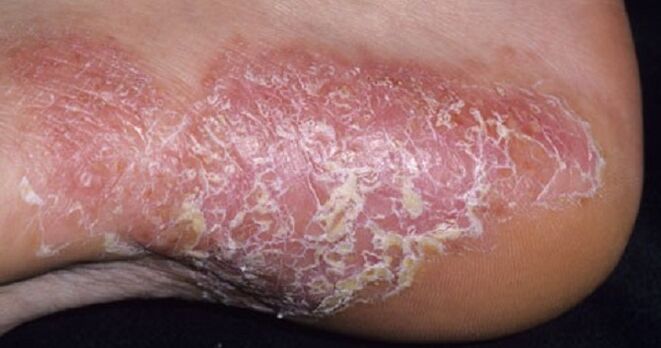Psoriasis on the legs is a skin condition that causes itchy papules, spots, or pustules to appear on certain parts of the limbs. Over time, they grow and merge into plaques. This disease is incurable and chronic. Well-designed complex therapy will help to quickly relieve the symptoms of psoriasis on the legs. Therefore, in order to achieve stable remission (to completely or partially rid the skin of the elements of the rash), one should not prescribe any treatment.
Causes of pathology
Scientists have not yet figured out why psoriasis occurs on the feet and other parts of the body. Many researchers associate a psoriatic rash with a genetic malfunction in the cells of the epidermis and the subsequent excessive activity of the immune system. This pathological condition occurs as follows:
- Due to a dysfunction of the skin, the keratinocytes (they make up 90% of the cells of the epidermis) do not have time to mature, but at the same time they multiply quickly, which leads to a change in the structure of individual areas of the skin.
- In response to such a failure, the body's own immunity sends T lymphocytes (killer cells) and macrophages (phagocytes) to destroy immature and pathologically altered keratinocytes.
- Due to the accumulation of large numbers of immune cells and keratinocytes in the upper layers of the epidermis, the skin grows and begins to peel off. No medication can help completely normalize the functions of skin renewal.
The progression of psoriasis on the legs is favored by a bacterial infection that can penetrate the skin through small scratches, as well as an impaired hormonal background, contact allergic dermatitis and a number of other external factors.
What does psoriasis look like on the legs, depending on the type of disease
Psoriatic lesions on the feet and knees of the legs can look different from person to person. This factor is explained by the cyclical course of the disease. In addition, one or more forms of psoriasis can develop on the skin of the legs, including palmar-plantar, common (vulgar), teardrop, punctiform, and nail and joint psoriasis.
Psoriasis of the legs and feet
Elements of psoriatic rashes can be localized on different parts of the skin of the legs:
- on the knees;
- on the shins;
- on the heels;
- in the thighs.
Psoriasis on the lower leg, foot, knee joint and the inner thigh begins with the appearance of individual red papules and severe itching (typical of the punctiform and vulgar form of the disease) or with small pink and purple spots (with teardrop-shaped psoriasis).

In the first case, the elements of the rash protrude slightly above the surface of the skin, differ in density and have a tip with a silvery scales that flake off when scratched with a fingernail. Over time, the papules increase, and those that are close together merge into a single plaque. As a result, they completely cover the skin of the knees or cover solid areas of skin from the knees to the feet. Peeling occurs on the surface of the plaques.

At the initial stage, teardrop-shaped elements of the psoriasis rash affect the entire skin of the legs with the same type of small rash. As the disease progresses, individual spots merge into groups and cover large areas of skin on the legs. Such psoriasis lesions rarely appear on the heels.

Palmar-plantar psoriasis often develops on the sole of the foot. On the inflamed skin of the feet, elements of the rash are formed in the form of small spots and pustules with clear borders and yellow sterile contents. When the pustules on the legs open, the fluid flows out of them, dries up and forms a yellowish crust, the ulcers underneath also dry out.
Pustules that do not burst become covered with dry scales. Gradually they increase and combine into groups, the cuticle begins to tighten the skin strongly, which causes discomfort when walking. The skin around the plaques becomes thick and dry and cracks. It is through such cracks that infection usually penetrates the deep layers of the dermis, after which the weeping and deterioration of the skin begins.
Psoriatic arthritis
In most cases, plaque psoriasis of the legs leads to psoriasis damage to the joints. This arthritis is divided into 5 types:
- Symmetrical - simultaneous inflammation of the paired joints of the knees, hips, ankles or feet.
- Asymmetrical - pathological changes affect both large and small joints, for example, the joints of a knee and the toe joints.
- Inflammation of the distal joints - the small joints on the toes that are closer to the nails swell.
- Spondylosis - Arthritis affects the lumbar spine and causes pain in the hips and lower extremities.
- Deforming arthritis is a rare inflammatory pathology in which the small joints of the fingers are completely destroyed.
The skin over the swollen joints swells, turns purple-blue, and becomes hot.
Damage to the nail plates
Psoriatic nail damage occurs against the background:
- Psoriatic arthritis in 80-90% of cases;
- vulgar or pustular psoriasis in 50-60% of cases.
In 5-10% of clinical cases, toenail psoriasis is primary, that is, it occurs on its own, no psoriasis lesions of the joints or skin of the legs precede it.
Frequent psoriasis on the soles of the feet or psoriasis inflammation of the distal finger joints initially cause pathological changes in the skin of the periungual region. Then the pathology spreads to the nail bed or affects the nail plate lying on it. There is a deformation of the nail - the formation of dents, transverse lines - and discoloration of the plate.
Similar signs of psoriasis in women are rarely observed in adolescence, most often the disease occurs in young men. In old age, both women and men are equally affected by psoriatic nail damage.
Progress Levels
If left untreated, psoriasis of the lower extremities goes through 3 stages of development:
- Initial;
- progressive;
- stationary.
After that, the pathological changes are suspended, the stage of remission begins. Without preventive treatment, the disease will resume over time.
The manifestation of the initial stage of the disease on the legs is characterized by the formation of a small single rash in the form of spots, papules or pustules. First of all, it can appear in the flexions of both knees of the legs at the same time. The elements of the rash are red or pink, then their tips are covered with white scales. The initial stage of psoriasis lasts about 3 weeks. During this time, papules or pustules increase in size and form groups.
The early stages of psoriasis can be stopped if you seek help from a specialist immediately. But most often people ignore the symptoms of the manifestation of the disease, which is why psoriasis continues to develop. As the stage progresses, the number of psoriatic plaques on the skin of the legs increases, those that are close to each other merge into "paraffin lakes" of various shapes and sizes. Psoriasis on the toes causes inflammation and flaking of the periungual tissue and damage to the nails.
The Kebner phenomenon is characteristic of the advancing period when a psoriasis rash forms on the healed skin, for example after a cut or scratch.
In the stationary stage, psoriasis of the feet and other areas of the skin of the legs still manifests itself as severe itching and flaking. However, new elements of the rash no longer appear and the plaques no longer grow. There is no inflammatory edge around them, dry flakes appear instead. If treatment is stopped at this point, the disease will start to get worse again. Otherwise, the psoriatic plaques will stop peeling off, some of them will disappear completely, others will only get lighter - the stage of remission begins.
How to treat psoriasis on the legs
The treatment regimen for psoriasis on the legs is drawn up for each patient separately, taking into account the location of the rash, the form of the disease, the stage of its progression and a number of other factors. It is dangerous to independently invent a treatment for this disease, since complications can appear in the form of extensive skin lesions, inflammation of the joints, up to their destruction and the addition of a bacterial (staphylococcal, streptococcal) infection.
medication
First, the foci of psoriasis are affected by non-hormonal ointments:
- Tar, naphthalan ointments soothe inflammation, are antiseptics, but should only be used as directed by a doctor, as they have serious contraindications.
- Sulfur salicylic ointment, salicylic acid - see keratolytics (destruction of the stratum corneum). They have an exfoliating effect and help dissolve the plaques.
- Ointments containing Solidol soften the skin of the legs, have a regenerative effect.
- Ointments containing the active form of vitamin D3 slow down the process of cell division, thereby reducing inflammation and peeling of the skin on the legs.
If non-hormonal drugs do not stop psoriasis of the legs, then corticosteroid ointments are prescribed, which are divided into:
- Weakly active - the funds act on the surface of the skin, suitable for the initial stage of psoriasis. Some ointments from this group are approved for children, pregnant and breastfeeding women.
- Moderately active - prescribed for the treatment of psoriasis on rough skin areas of the legs, especially the knees and soles of the feet.
- Strongly active - is prescribed when medium-quality ointments can not stop the increase in psoriatic plaques on the skin of the legs.
If no ointment for psoriasis helps, then at the stage of the progression of the disease, pills are prescribed simultaneously with external drugs for:
- Suppression of the activity of immune cells;
- Preventing the proliferation of epidermal cells;
- they also take retinoids - derivatives of vitamin A that are needed to restore epidermal cells.
How to get rid of psoriasis on the feet using home methods
Folk remedies for psoriasis are drugs for external and internal use, but when treating them, they should be used just as carefully as drugs.
Questions about how to cure psoriasis forever at home remain unanswered. Some homemade recipes will help get rid of the symptoms of the disease for a long time, but not completely get rid of them.
Ointment against aggravation
Ingredients:
- unrefined sunflower oil - 1 liter;
- Celandine - 50 g;
- Elephant roots - 50 g;
- acetylsalicylic acid - 50 tab.
Preparation: grind tablets and herbs with a coffee grinder, pour the resulting powder into vegetable oil, mix thoroughly. Let it steep for 30 days in a warm, dark place. During this time, the mixture should be heated in the steam bath with stirring every 3 days, but not brought to a boil.
Application: strain the drug, mix the resulting liquid with petroleum jelly (3: 1), apply to psoriatic plaques three times a day.
Ointment that relieves symptoms in 10 days
Ingredients:
- Birch tar - 150 g;
- pharmacy alcohol - 150 mg;
- Camphor oil - 75 mg;
- Chicken egg yolk - 3 pcs.
How to cook: beat the yolks in an enamel container, gradually adding camphor, then tar and alcohol. Keep the ointment in a dark place.
Application: Apply to the inflamed skin of the legs with a gauze swab. After three days, you need to wash your feet with warm water with a foam of tar soap, blot the moisture and reapply the ointment for 3 days. If the disease does not start, the process is repeated again, after which the skin is cleaned.
During treatment with homemade ointments, it is very important to maintain the body's immunity. For this, 1 teaspoon can be taken orally daily. Sea buckthorn oil.
diet
Proper nutrition is one of the prerequisites for effective treatment of psoriasis not only on the legs, but on other parts of the body as well. Doctors came to the conclusion that the allergic factor contributes to the progression of all forms of psoriasis, therefore allergenic foods should first be excluded from the menu:
- Chicken eggs;
- Seafood;
- natural honey;
- Chocolate, cocoa;
- Grape;
- Lamb;
- Pork meat;
- Chicken;
- Alcohol.
During this period it is very important to avoid sweet, spicy, too salty and smoked foods - they slow down the metabolism in the body. The menu should include dairy products, river fish, cereals, baked apples, vegetable oils, green peas and carrots.

Complete starvation in psoriasis when a person drinks just one water is contraindicated.
During an exacerbation of psoriasis on the legs, doctors recommend arranging a day of fasting once a week, for example, eating only apples, kefir or boiled river fish.
physical therapy
The answer to the question of how to treat psoriasis on the leg with physical therapy is quite extensive. For this purpose, doctors prescribe:
- Ultrasound Therapy - Ultrasound waves emanating from the device compress and stretch skin tissues to restore their cells. In this way, it is possible to relieve inflammation, itching and swelling of the skin of the legs.
- Electrosleep - prescribed for psoriasis of the skin of the legs, when a person cannot cope with the stress caused by the pathology.
- Phototherapy - under the influence of ultraviolet rays, the immunity of the skin is strengthened, the rate of growth and cell division decreases.
To improve metabolic processes in the skin of the legs in psoriasis, acupressure helps. It is recommended to do it only during remission of the disease, otherwise there is a high probability of infection of the inflamed skin.
Hygiene rules
In order not to cause new psoriatic plaques on the skin of the legs, it is recommended to use only warm water and baby toilet soap with a moisturizing effect to wash the skin during remission. As the disease progresses, feet should be washed with warm water and tar soap, which not only cleanses the skin, but also relieves inflammation. After washing, dry your skin and toenails thoroughly with a soft towel.
Additional recommendations
Treatment for psoriasis on the legs is long-term when a person:
- He does an active sport - his legs sweat, the feet are put under a lot of stress. After exercising, it is very important to wash your feet with lukewarm water, dry them thoroughly, put on clean socks and loose shoes that allow the skin to breathe.
- Tans regularly and for long periods in the sun - excessive sunbathing causes burns and affects the skin's metabolic processes. At the stage of the progression of psoriasis on the skin of the legs, it is better to refuse extensive sunbathing, and in remission, a sunscreen should be used.
Preventive measures and prognosis
Today psoriasis is considered incurable. Therefore, after continued symptom relief, attempt should be made to maintain this condition in the manner recommended by the doctor. There is no room here for self-medication.

























